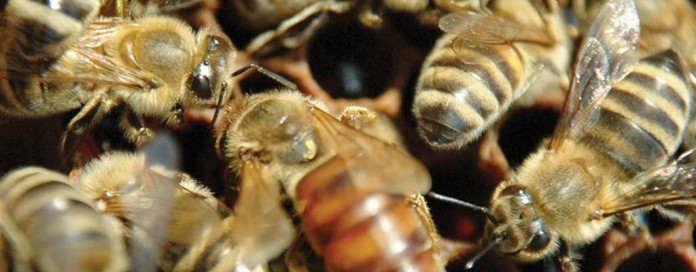The sign of dead bees outside a honey bee hive is actually a good sign, believe it or not. That’s what beekeeper and Scioto County Farm Bureau member Wyatt Bates said when he inspected his hive at the end of winter, noting that lives bees inside the hive are pushing dead bees outside. According to the Ohio Farm Bureau Federation, if there is no sign of life around a hive once winter ends, it means that the bees didn’t make it through the cold season.
Based on preliminary statistics released May 13 from the Bee Informed Partnership, from April 2014 to April 2015, 42.1 percent of beekeepers of their total number of colonies over the last year. Ohio reported a 49.8 percent annual loss between 2014 and 2015, based on reported numbers from surveyed beekeepers. The New York Times reports that for the first time, summer honey bee deaths surpassed winter bee deaths in 2014. That’s a startling thought when the pollination that honey bees complete is worth between $10 billion and $15 billion.
What’s causing so many honey bees to die? Pesticides, the varroa mite, harsh winters and even decline in the number of wildflowers are contributing to the increased death rate of honeybees in the United States. Pesticides affect honey bee populations by creating stress on them. Varroa mites are parasites that attack honeybees, infect them with viruses and ultimately kill them. Colony collapse disorder (CCD) was to blame for a sharp decline in bee populations beginning in 2006, but now instead of adult bees disappearing, they’re dying.
Honeybees are responsible for pollinating more than 70 crops. In Ohio, the average honey bee colony needs 600 pounds of nectar each year, but that’s difficult to come by when plants like alfalfa and clover have diminished in numbers.
Researchers are working to determine where honey bees thrive best. OFBF reports that at The Ohio State University, researchers have found that honey bees thrive during the fall in rural areas when high nectar flowers are in bloom.
More about the honeybee situation:
- Honey bee habitat: Ohio funding available in early 2015 Nov. 14, 2014
- Northwestern Ohio study looks at pollinators Nov. 6, 2014
- Cost-share help for Ohio’s honeybees June 17, 2014
- Four common pesticides toxic to honeybee larvae, study finds Jan. 29, 2014
- Penn State receives grants to study pesticide risk and honeybees Jan. 17, 2014










